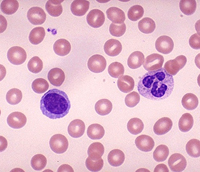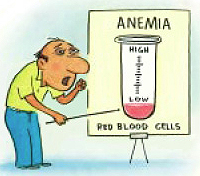 Examine a human peripheral blood
smear. Examine a human peripheral blood
smear.
- This smear was prepared with
polychromatic Wright's stain, which stains both basophilic and
acidophilic cellular components.
- This is a typical sample of
circulating blood, containing mature erythrocytes and
leukocytes.
Erythrocytes are red blood cells and
are recognized by their anuclear, biconcave shape. Since
erythrocytes are the most abundant cells in blood, they will
predominant in your field of view. The various kinds of leukocytes
are all much less numerous. Lymphocytes have spherical nuclei with
relatively little cytoplasm.
- Note their uniform diameter of
about 7 um. Red blood cells can be found in capillaries of most
tissues to be examined in this course and their size can provide
a measuring standard by which to estimate sizes of other tissue
structures.

Clinical note: Anemia is the
term applied to any significant reduction in the total mass of
erythrocytes or in their content of hemoglobin. Iron-deficiency
anemia results from having too little iron available for hemoglobin
synthesis. The hereditary disease sickle-cell anemia involves a
mutation that produces a single amino acid substitution in
hemoglobin, which makes the protein crystallize within erythrocytes
at low-oxygen tensions. This alters the cells overall shape and can
lead to microvascular blockage and various other problems.
Now let's take a look at some
white blood cells. |